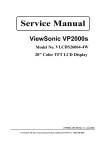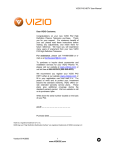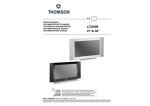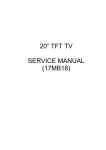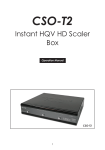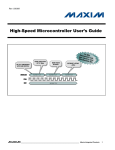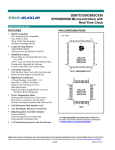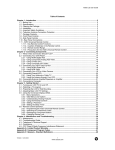Download Service Manual - National Service Alliance
Transcript
Service Manual Model #: VIZIO L30WGU V, Inc 320A Kalmus Drive Costa Mesa, CA 92626 TEL : +714-668-0588 FAX :+714-668-9099 Top Confidential Table of Contents CONTENTS PAGE Sections 1. Features 1-1 2. Specifications 2-1 3. On Screen Display 3-1 4. Factory Preset Timings 4-1 5. Pin Assignment 5-1 6. BLOCK DIAGRAM 6-1 7. Main Board I/O Connections 7-1 8. Theory of Circuit Operation 8-1 9. Waveforms 9-1 10. Trouble Shooting 10-1 11. Spare Parts List 11-1 12. Complete Parts List 12-1 Appendix 1. Main Board Circuit Diagram 2. Main Board PCB Layout 3. Assembly Explosion Drawing Block Diagram VIZIO L30WGU Service Manual VINC Service Manual VIZIO L30WGU COPYRIGHT © 2000 V, INC. ALL RIGHTS RESERVED. IBM and IBM products are registered trademarks of International Business Machines Corporation. Macintosh and Power Macintosh are registered trademarks of Apple Computer, Inc. VINC and VINC products are registered trademarks of V, Inc. VESA, EDID, DPMS and DDC are registered trademarks of Video Electronics Standards Association (VESA). Energy Star is a registered trademark of the US Environmental Protection Agency (EPA). No part of this document may be copied, reproduced or transmitted by any means for any purpose without prior written permission from VINC. FCC INFORMATION This equipment has been tested and found to comply with the limits of a Class B digital device, pursuant to part 15 of the FCC Rules. These limits are designed to provide reasonable protection against harmful interference in a residential installation. This equipment generates, uses and can radiate radio frequency energy, and if not installed and used in accordance with the instructions, may cause harmful interference to radio communications. However, there is no guarantee that the interference will not occur in a particular installation. If this equipment does cause unacceptable interference to radio or television reception, which can be determined by turning the equipment off and on, the user is encouraged to try to correct the interference by one or more of the following measures -- reorient or relocate the receiving antenna; increase the separation between equipment and receiver; or connect the into an outlet on a circuit different from that to which the receiver is connected. FCC WARNING To assure continued FCC compliance, the user must use a grounded power supply cord and the provided shielded video interface cable with bonded ferrite cores. Also, any unauthorized changes or modifications to Amtrak products will void the user’s authority to operate this device. Thus VINC Will not be held responsible for the product and its safety. CE CERTIFICATION This device complies with the requirements of the EEC directive 89/336/EEC with regard to “Electromagnetic compatibility.” SAFETY CAUTION Use a power cable that is properly grounded. Always use the AC cords as follows – USA (UL); Canada (CSA); Germany (VDE); Switzerland (SEV); Britain (BASEC/BS); Japan (Electric Appliance Control Act); or an AC cord that meets the local safety standards. VIZIO L30WGU Service Manual Chapter 1 Features 1. Built in TV channel selector for TV viewing 2. Simulatnueous display of PC and TV images 3. Connectable to PC’s analog RGB port and digital port 4. Connectable to digital port HDCP 4. Built in s-video, HDTV, composite video and TV out 5. Built in auto adjust function for automatic adjument of screen display 6. Smoothing function enables display of smooth texts and graphics even if image withresolution lower than 1280x768 is magnified 7. Picture In Picture (PIP) funtion to show TV or VCR images 8. Power saving to reduce consumption power too less than 3W 9. On Screen Display: user can define display mode (ie color, brightness, contrast, sharpness), sound setting, PIP, TV channel program, aspect and gamma or reset to factory setting. CONFIDENTIAL – DO NOT COPY Page 1-1 File No. SG-0156 Chapter 2 Specification 1. LCD CHARACTERISTICS Type: WXGA TFT LCD Size: 30 inch Active Screen Size: 29.53 inches Outline Dimension: 683.6(H) x 431.8(V) x 41.6(D) Display Area: 643.20 (H) x 385.92(V) Pixel Format: 1280 horiz. By 768 vert. Pixels RGB strip arrangement Display Color: 16.7M colors Luminance, White: 600 cd/m2 (Typ) Power Consumption: 6.6Watt (Typ.) Weight 5000 g (Typ.) Display Operating Mode: Transmissive mode, normally Black Surface Treatment: Hard coating (2H), Anti-glare treatment of the front polarizer, 2. OPTICAL CHARACTERISTICS 2-1. Viewing Angle by Contrast Ratio °Ÿ 10 Left: 85°typ. Right: 85°typ. Top: 85°typ. Bottom: 85°typ. 3. SIGNAL (Refer to the Timing Chart) 3-1. Sync Signal (1) Type: TMDS (2) Input Voltage Level: 90~240 Vac, 50/ 60 Hz (3) Input Impedance: 50£[/ Signal line 3-2. Operating Frequency RGB Signal: H: support to 30K~70KHz V: support to 50~85Hz Pixel Clock: support to 110MHz DVI Signal: H: support to 30K~80KHz V: support to 50~85Hz Pixel Clock: support to 110MHz CONFIDENTIAL – DO NOT COPY Page 2-1 File No. SG-0156 S-Video Video (Y): Analog 0.1Vp-p/75Ω Video (C): Analog 0.286p-p/75Ω Component signal: YCbCr H: 15.734KHz V: 60Hz (NTSC-interlace) H: 31KHz V: 60Hz (NTSC-progressive) YPbPr H: 15.734KHz V: 60Hz (NTSC-480i) H: 31KHz V: 60Hz(NTSC-480p) H: 45KHz V: 60Hz(NTSC-720p) H: 33KHz V: 60Hz(NTSC-1080i) Composite Video signal: H: 15.734KHz V: 60Hz (NTSC) F-Type TV RF signal: H: 15.734KHz V: 60Hz (NTSC) Audio Signal: Frequency Response: 250 Hz-20KHz 4.Input Connectors a. RJ11 (For RS232 Controls) b. 24-pin DVI (For DVI/HDCP input) c. RCA x2 ((For DVI/HDCP input) d. D-sub 15pin x 1 (For Analog RGB) e.Mini Jack (L,R) x 1 (For PC analog Audio input) f. YPbPr RCA x 3 (For HDTV input) g. YCbCr RCA x 3 (For DVD input) h. S-Video 4pin DIN x 1 i. RCA x3 (For CVBS A/V input#1) j. RCA x 3(For CVBS A/V input#2) k. F-terminal RF l. CVBS RCA x 3 (For CVBS A/V output) 5. POWER SUPPLY Consumption: 170W MAX DPM Mode Not Active OFF: less than 3 W Low (20%) Power OFF: to less than 3W CONFIDENTIAL – DO NOT COPY Page 2-2 File No. SG-0156 6.Speaker Output 8Ω/5W (max) X2 7. ENVIRONMENT Operating a. Temperature: 5~35℃ b. Relative humidity: 10~90% c. Altitude: 0~10,000ft Non-operating a. Temperature: -20~50℃ b. Relative humidity: 10~90% c. Altitude: 0~40,0000ft 8. DIMENSIONS (with TILT/SWIVEL) GATEWAY VERSION a. Height: 601.1mm b. Width: 740.0mm c. Depth: 198.0mm Wynn version a. Height: 522.0mm b. Width: 740.0mm c. Depth: 100.5mm 9. WEIGHT (with TILT/SWIVEL) GATEWAY version a. Net: 19.1kgs b. Gross: 25.8kgs Wynn version a. Net: 14.1kgs b. Gross: 20.8kgs CONFIDENTIAL – DO NOT COPY Page 2-3 File No. SG-0156 Chapter 3 On Screen Display Main unit button Power Source MENU PROG ▲ PROG ▼ Sound + Sound Auto OSD Adjustment 1. PC Analog A. Picture: a. Brightness b. Contrast c. Auto picture d. Manual picture: 1. V position 2. H size 3. H position 4. Fine tune e. Sharpness: 1~5 f. Color Temp (User, 9300k, 6500k, 5000k) 1. R (Red setting) (0~100) 2. G (Green setting) (0~100) 3. B (Blue setting) (0~100) B. Audio: a. Volume b. Treble c. Bass d. Balance e. Spatial CONFIDENTIAL – DO NOT COPY Page 3-1 File No. SG-0156 C. Setup: a. Language (English, France, Spain) b. Gamma (Linear, Vivid1, Vivid2, Vivid3) c. Wide (Panoramic, Widescreen, Zoom, Standard) d. PiP: 1. Switch (On/Off) 2. Style (Off, Small, Large) 3. Pos (Upper left, Upper center, Upper right Middle left, Middle right, lower left, lower center, lower left) 4. Source (TV, DVD, AV2/S, AV1) 5. PiP TV Channel e. OSD style (Translucent, Opaque) f. IR Command Set (A, B, C) 2. PC digital A. Picture: a. Brightness b. Contrast c. Sharpness d. Color Temp User, 5000k, 6500k, 9300k R (Red setting) G (Green setting) B (Blue setting) B. Audio: a. Volume b. Treble c. Bass d. Balance e. Spatial C. Setup: a. Language (English, France, Spain) b. Gamma (Linear, Vivid1, Vivid2, Vivid3) c. Wide (Panoramic, Widescreen, Zoom, Standard) d. PiP: CONFIDENTIAL – DO NOT COPY Page 3-2 File No. SG-0156 1. Switch (On/Off) 2. Style (Off, Small, Large) 3. Pos (Upper left, Upper center, Upper right Middle left, Middle right, lower left, lower center, lower left) 4. Source (TV, DVD, AV2/S, AV1,) 5. PiP TV Channel e. OSD style (Translucent, Opaque) f . IR Command Set (A, B, C) 3.AV2/S, AV1, DVD, HDTV Mode A. Video: a. Brightness b. Contrast c. Color d. Tint e. Sharpness (1~5) f. Color Temp (normal, Warm, Cool) g. Noise Reduct B. Audio: a. Volume b. Treble c. Bass d. Balance e. Spatial C. Setup: a. Language (English, France, Spain) b. Gamma (Linear, Vivid1, Vivid2, Vivid3) c. Wide (Panoramic, Widescreen, Zoom, Standard) d. PiP: 1. Switch (On/Off) 2. Style (Off, Small, Large) 3. Pos (Upper left, Upper center, Upper right Middle left, Middle right, lower left, lower center, lower left) 4. Source (TV, DVD, AV2/S, AV1) 5. PiP TV Channel e. OSD style (Translucent, Opaque) f . IR Command Set (A, B, C) CONFIDENTIAL – DO NOT COPY Page 3-3 File No. SG-0156 4. TV A. Video: a. Brightness b. Contrast c. Color d. Tint e. Sharpness f. Color Temp (normal, Warm, Cool) g. Noise Reduct B. Audio: a. Volume b. Treble c. Bass d. Balance e. Spatial f. MTS (Mono, Stereo, SAP) C. TV: a. Source (Antenna, Cable) b. Cable mode (auto, std, Hrc, irc) c. Channel scan d. CC Mode (CC1, CC2 Text1, Text2) e. Parental Control 1. Change password (New password, Confirm password) 2. Setup TV Blocking 3. Setup Movie Blocking 4. Blocking Enable (On/Off) 5. Key Lockout (On, Off, All, All but power) 6. IR Lockout (On/Off) 7. Factory reset (Yes/No) D. Setup: a. Language (English, France, Spain) b. Gamma (Vivid1, Vivid2, Vivid3 and liner) c. Wide (Panoramic, Widescreen, Zoom and Standard) d. PiP 1. Switch (On/Off) 2. Style (Off, Small, Large) 3. Pos (Upper left, Upper center, Upper right CONFIDENTIAL – DO NOT COPY Page 3-4 File No. SG-0156 Middle left, Middle right, lower left, lower center, lower left) 4. Source (TV, DVD, AV2/S, AV1) 5. PiP TV Channel e. OSD style (Translucent, Opaque) f . IR Command Set (A, B, C) CONFIDENTIAL – DO NOT COPY Page 3-5 File No. SG-0156 Chapter 4 Factory preset timings This timing chart is already preset for the TFT LCD analog & digital display monitors. Resolution Refresh rate Horizontal Vertical Horizontal Vertical Pixel Frequency Frequency Polarity Polarity Rate 640x480 60Hz 31.5kHz 59.94Hz N N 25.175 640x480 75Hz 37.5kHz 75.00Hz N N 31.500 800X600 60Hz 37.9kHz 60.317Hz P P 40.000 800x600 75Hz 46.9kHz 75.00Hz P P 49.500 800X600 85Hz 53.7kHz 85.06Hz P P 56.250 1024x768 60Hz 48.4kHz 60.01Hz N N 65.000 1024X768 75Hz 60.0kHz 75.03Hz P P 78.750 720x400 70Hz 31.46kHz 70.08Hz N P 28.320 1280x768 60Hz 47.98kHz 59.83Hz P N 81.000 1280x768 75Hz 60.15kHz 75.00Hz P N 102.977 Remark: P: positive N: negative Native Resolution Mode No Resolution Refresh Rate Horizontal Vertical Frequency Frequency Vertical Horizontal Sync Sync Polarity Polarity Dot rate (Hz) (K Hz) (Hz) (TTL) (TTL) (MHz) 9 1280x768 60 47.98 59.83 - + 81MHz 10 1280x768 75 60.15 75.00 - + 102.977MHz CONFIDENTIAL – DO NOT COPY Page 4-1 File No. SG-0156 Chapter 5 Pin Assignment The TFT LCD analog display monitors use a 15 Pin Mini D-Sub connector as video input source. Pin Description 1 Red 2 Green 3 Blue 4 Ground 5 Ground 6 R-Ground 7 G-Ground 8 B-Ground 9 +5V for DDC 10 Ground 11 No Connection 12 (SDA) 13 H-Sync (Composite Sync) 14 V-Sync 15 (SCL) 1 5 6 11 CONFIDENTIAL – DO NOT COPY 10 15 Page 5-1 File No. SG-0156 The TFT LCD digital display monitors use a 24 Pin DVI_D connector as video input source. Pin Description 1 TMDS negative differential input, channel 2 2 TMDS positive differential input, channel 2 3 Logic Ground 4 Reserved. No connection 5 Reserved. No connection 6 DDC2B Clock 7 DDC2B Data 8 Reserved. No connection 9 TMDS negative differential input, channel 1 10 TMDS positive differential input, channel 1 11 Logic Ground 12 Reserved. No connection 13 Reserved. No connection 14 Power 15 Logic Ground 16 SENSE Pin, Pull High 17 TMDS negative differential input, channel 0 18 TMDS positive differential input, channel 0 19 Logic Ground 20 Reserved. No connection 21 Reserved. No connection 22 Logic Ground 23 TMDS positive differential input, reference clock 24 TMDS negative differential input, reference clock CONFIDENTIAL – DO NOT COPY Page 5-2 File No. SG-0145 Four-Pin mini DIN S-Video Connector Signal Level Video (Y) : Analog 0.1Vp-p/75Ω Frequency Video (C) : Sync (H+V) : H: 15.734Khz Analog 0.286p-p/75 0.3V below Video (Y) V: 60HZ (NTSC) Video Output Connector Signal Level Video (Y+C) : Analog 0.7Vp-p/75Ω Sync (H+V): 0.3V below Video (Y+C) RGB Signal a. Sync Type b. Sync polarity c. Video Amplitude d. Frequency TTL (Separate / Composite) or Sync. On Green Positive or Negative RGB: 0.7 Vp-p H: support to 30k~70kHZ V: support to 50~85MHZ Audio Signal: a. Signal Level 1Vrms b. Frequency Response 250HZ – 20kHZ CONFIDENTIAL – DO NOT COPY Page 5-3 File No. SG-0145 Component Signal Ycbcr a. Frequency H: 15.734kHZ H: 31kHZ b. Signal level Y: 1Vp-p c. Impedance 75Ω V: 60HZ (NTSC-interlace) V: 60HZ (NTSC-progressive) Cb: ±0.350Vp-p Cr: ±0.350Vp-p Ypbpr a. Frequency H: 15.764kHZ H: 31kHZ H: 45kHZ H: 33kHZ b. Signal level Y: 1Vp-p c. Impedance 75Ω CONFIDENTIAL – DO NOT COPY V: 60HZ (NTSC-480i) V: 60HZ (NTSC-480p) V: 60HZ(NTSC-720p) V: 60HZ(NTSC-1080i) pb±0.350Vp-p pr: ±0.350Vp-p Page 5-4 File No. SG-0145 Chapter 6 Block Diagram System Block Diagram 30” WXGA panel AC IN Digital Video bus Power Board DC 12V W6 Speakers W5 JT2 Main Board W3 W4 □□□□□ Keypad/IR Board W9 W1 JT3 DVI D-Sub Audio JT11 YPbPr JT10 JT8 JT5 YCbCr S-Video AV1/AV2 RF The monitor’s system block diagram is powered by power board that transforms AC source of 100V~240V AC +/- 10% @ 50/60 HZ into DC 12V & 24Vsource. The DC source supplies three important parts of the system block diagram. They are the main board, and 30” WXGA panel unit. The main board receives different types of video signal. Afterward, the main board process the signals control the various functions of the monitor and outputs control signal, video signal and power to the 30” WXGA panel to be displayed. The inverter first processes the power send to the panel. The function of the inverter is to step up the voltage supplied by the main board to the power that is needed to light up the lamps in the panel. Simultaneously, the digital video signals are processed in the panel and the outcome determines the brightness, pixel on/off and the color displayed on the panel. CONFIDENTIAL – DO NOT COPY Page 6-1 File No. SG-0156 CONFIDENTIAL – DO NOT COPY Page 6-2 File No. SG-0145 The function of the Main board is to receive different types of video and audio signal in to compatible digital video and audio format. The FQ1236-MK3 tuner processes the TV antenna and the cable into analog signal. The audio signal exiting from FQ1236-MK3 is further processed by MSP3440G. The purpose is to process the input IF signal into AF signal and control TV sound signal features like volume, bass, treble and balance. The processing procedure conforms to standard recommend for Broadcast Television System Committee (BTSC). The analog video signals of S-video, YPbPr, TV and A/V signals travel directly to video decoder. At the decoder, all signals are translated from analog signals into compatible digital signal which will be ultimately be processed by theVP3230 & SAA7118. After the video signal has been converted into digital signals, the digital video signal is de-interlaced by FLI3210. The de-interlace processor automatically determines and de-interlace the incoming video content – static or motion and applies different algorithm to each of the content type. An external SDRAM is used to help store the video fields and motion video data processed in FLI3210. More over, the internal memory controller in FLI3210 controls the external SDRAM. What’s more, FLI3210 offer programmable functions like video enhancement and PIP (picture in picture). PIP functions by activating the primary and secondary port simultaneously. In short, FLI3210 output (display port) digital signals up to 74 Mpixel/sec to the PW166B generate the vertical and horizontal timing signals for display device. All functions are controllable by the main board. Plus, all functions in the IC boards are programmable using I2C Bus. CONFIDENTIAL – DO NOT COPY Page 6-3 File No. SG-0145 Chapter 7 W3 W4 W6 Main Board I/o Connections CONNECTION (TOP→BOTTOM) "OSD CONTROL Pin Description 1 “Auto” 2 “Left” 3 “Right” 4 “Down” 5 “Gnd” 6 “Up” 7 “Menu” 8 “Source” CONNECTION (TOP→BOTTOM) Pin Description 1 “Power” 2 “U17” 3 “V50” 4 “Gnd” 5 “Vpcon” CONNECTION (TOP→BOTTOM) Pin Description 1 “V120dc” 2 “V120dc” 3 “V120dc” 4 “Gnd” 5 “Gnd” 6 “Gnd” 7 “Bk_Light” 8 “Pwm_p” CONFIDENTIAL – DO NOT COPY Page 7-1 File No. SG-0156 Chapter 8 Theory of Circuit Operation The operation of D-SUB 15pin route The D-SUB 15pin is input analog signal into the video switch M61323fp. Then, the signal is process to the A/D converter (ADC9883) and output to the pw166B; the pw166B generates the vertical and horizontal timing signals for display device. The operation of DVI & HDCP CON route The DVI & HDCP CON is input digital signal the signal is process to the sil169. Then transfer to the pw166B, the pw166B generates the vertical and horizontal timing signals for display device. The operation of HDTV & DVD route HDTV & DVD signal is transfer to video switch M61323fp, the M61323fp can to determine signal witch one signal is to the VP3230 (decoder) and witch one is to ADC9883. When signal transfer for the VP3230 (decoder) and output to FLI2310 (de-interlace) then transfer the pw166B generates the vertical and horizontal timing signals for display device. When signal to the ADC9883 then output to pw166B generates the vertical and horizontal timing signals for display device. The pip mode is signal to saa7118 (decoder) then transfer to the pw166B generates the vertical and horizontal timing signals for display device. The operation of S-Video route The S-Video signal is input to TA1218N (switch) then transfer signal to VP3230 (decoder) and output to FLI2310 (de-interlace) then use graphic port transfer signal to pw166B generates the vertical and horizontal timing signals for display device. The pip mode is signal to saa7118 (decoder) then transfer to the pw166B generates the vertical and horizontal timing signals for display device. The operation of Video 1,2 route Video 1,2 signal input to TA1218N (switch) and transfer signal to VP3230 (decoder) and output to FLI2310 (de-interlace), then transfer to the pw166B generates the vertical and horizontal timing signals for display device. The pip mode is transfer to saa7118 (decoder) then transfer to the pw166B generates the vertical and horizontal timing signals for display device. The operation of TV route TV signal is processes to the tuner and output to TA1218N (switch) then transfer to VP3230 (decoder) and output toFLI2310 (de-interlace) then transfer to pw166B generates the vertical and horizontal timing signals for display device. The pip mode is signal to saa7118 (decoder) then transfer to the pw166B generates the vertical and horizontal timing signals for display device. CONFIDENTIAL – DO NOT COPY Page 8-1 File No. SG-0156 The operation of keypad There are 8 keys to control and select the function of SHD-3010 and also have two LED to indicate the status of operation. They are “power, Source, MENU, ▼▲, + -, Auto” keys and LED. 1. The power key through POW and GND to control PW166B, PW166B will receive a low signal to turn on or off system while press the power key. 2. The other seven keys are on high state because the pull up resistor but will transit to low state dependent on which key pressed, and the state will be reader by PW166B through D0 to D6 to act corresponding function. 3. The LED is constructed with two separate LED which color is blue and Green. The PW166B direct control the LED’s when PW166B (VPCON) is low the LED is Green (Close power) when PW166B (VPCON) is high the LED is Orange (Open power). The operation of Analog port The analog port are consisted with 15 pins mini D-Sub connector which receiving video signal from host device, EEPROM which compliance with DDC1/DDC2B protocol, H-sync and V-sync detecting circuit which regenerate synchronous signal for PW166B detecting, video signal matching circuit and AD9883A which capturing RGB graphics signal and digitize each pixel. The pin assignment of 15 pins connector are as follows: Pin No. Pin Name Description 1 GRAI Red signal 2 GGAI Green signal 3 GBAI Blue signal 4 GND Ground 5 GND Ground 6 GND R-Ground 7 GND G-Ground 8 GND B-Ground 9 +5V For DDC 10 GND Ground 11 X No connection 12 RGSA SDA 13 GHSI H-Sync 14 RVSI V-Sync 15 RGSL SCL CONFIDENTIAL – DO NOT COPY Page 8-2 File No. SG-0156 RGB graphics signal of host device transmits to the analog port through pin 1 to 3. The video signal should be coupled to RIN, GIN, BIN and SOGIN of AD9883A through C78, C75, C74 and C76. The EDID data is stored in EEPROM (24LC21) which compliance with DDC1/DDC2B protocol that performs a plug and play function. When in DDC1 protocol the host device access the EDID data through RVSI (pin14) and RGSA (pin12) while RGSL (pin15) is held high. But in DDC2B protocol the host device access EDID data through RGSA (pin12) and RGSL (pin15). The SCL, SDA should be pull up through R28 R27 and are voltage limitation through D9, D8, and D5, which will limit to 5 volts. The PW166B let PORTA3 (ADCEN) to low state that will let FST3125 (U8C) to output GHS signal which are derived from AD9883A pin65 SOGOUT. When PW166B detects exact GHS and GVS timing it will configure the registers of AD9883A to satisfy the operation through SCL and SDA of IIC bus. Oppositely while PW166B let PORTB3 (DVI_ON) to high state it means that the analog port is disable, and should be in digital interface mode. While PW166B let PORTA6 (INSEL) PORTB4 (COMP_SEL) to High state it means that the YPbPr is disable, and DVD is enable. AD9883A is 8-bit 140 Msps monolithic analog interface for capturing RGB graphics signals from personal computers and workstations. It includes +1.25V reference, PLL to generate a pixel clock from Hsync, and programmable gain, offset, and clamp circuits. The function block of AD9883A is as follows: CONFIDENTIAL – DO NOT COPY Page 8-3 File No. SG-0156 If user changes to analog mode or analog port is resignaled from host device then PW166B will let PORTA6 (INSEL) to Low state that enables H-Sync, V-Sync, from AD9883A. The PW166B will changes the power mode PLL divide ratio, clock phase VCO range and charge pump current etc. that depends on the timing of GHS and GVS. The action should be fulfilled through SDA and SCL of IIC bus to change the data of control registers of AD9883A. The PLL derives a master clock from an incoming H-Sync signal. The master clock frequency is then divided by an integer value, and the divider’s output is phase-locked to H-Sync. The PLL characteristics are determined by the loop filter design, which controlled by PLL charge pump current (CURRENT) and VCO range setting (VCORNGE). The value of VCO range and charge pump current is as follows: Pixel Clock PV1 PV0 Inputs KVCO Gain Range (MHz) (MHz/V) 0 0 12–36 150 0 1 36–72 150 0 0 72–110 150 Mode Sync Power- Detect2 Down1 Full-Power 1 1 Powered On or Comments Everything Serial Bus, Sync Ip2 Ip1 Ip0 Current (µA) 0 0 0 50 0 0 1 100 0 1 0 150 0 1 1 250 1 0 0 350 1 0 1 500 1 1 0 750 1 1 1 1500 Seek Mode 1 0 Activity Detect, SOG, Band gap Reference Serial Bus, Sync Power-Down 0 X Activity Detect, SOG, Band gap Reference If we adjust contrast or brightness of analog port then the input gain or input offset should be modified through IIC bus. The power of AD9883A is supplied 3-3V. We can management the power of AD9883A through the register of itself. The H-Sync input is used as a reference to generate the pixel-sampling clock. A 5-bit value (PHASE) adjust the sampling phase in 32 steps across one pixel time, so it generate a stable timing relationship between HSOUT and DATACK to digitize the captured analog RGB data. The output data is aligned to the leading edge of HSOUT. If the signal of sync on green is detected by SOGIN then the SOGOUT will produce a digital composite sync. CONFIDENTIAL – DO NOT COPY Page 8-4 File No. SG-0156 DVI_D Interface The SiI169 Receiver uses Panel Link Digital technology to support HDTV and high-resolution digital displays for DTV and PC applications. It features High-bandwidth Digital Content Protection (HDCP) for secure delivery of high-definition video in consumer electronics products. The SiI 169 is a DVI 1.0 compliant digital-output receiver with built-in High-bandwidth Digital Content Protection (HDCP). It provides a simple, cost effective solution for DTVs implementing DVI-HDCP. Pre-programmed HDCP keys simplify manufacturing while providing the highest level of security. There is no need to use encrypted keys, program EPROM’s, or cure epoxy coating. the functional blocks of the chip . Panel Link TMDS Core The Panel Link TMDS core accepts as inputs the three TMDS differential data lines and the differential clock. The core senses the signals on the link and properly decodes them providing accurate pixel data. The core outputs the necessary sync signals (HSYNC, VSYNC), clock (ODCK), and a display enable (DE) signal that drives high when video pixel data is present. The SCDT signal is output when there is active video on the DVI link and the PLL has locked on to the video. SCDT can be used to trigger external circuitry, indicating that an active video signal is present; or used to place the device outputs in power down when no signal is present (by tying SCDT to PDO#). A resistor tied to the EXT_RES pin is used for impedance matching. CONFIDENTIAL – DO NOT COPY Page 8-5 File No. SG-0156 HDCP Keys EEPROM The SiI 169 comes pre-programmed with a production set of HDCP keys in its internal EEPROM. In this way the keys are provided the highest level of protection as required by the HDCP specification. Silicon Image manages all aspects of the key purchasing and programming. There is no need for the customer to purchase HDCP keys from the licensing authority. For security reasons, the keys cannot be read out of the device. Samples of the SiI 169 are available with the B1 public keys as listed in the back of the HDCP specification. These are marked with a -PUB part number as noted in the Ordering Information section. Make sure to request either “Public” or “Production” keys when requesting samples. Before receiving samples of the SiI 169 with production keys a customer must have signed the HDCP license agreement. HDCP Operation The SiI 169 supports High-bandwidth Digital Content Protection (HDCP) by decrypting the pixel data stream received from an HDCP transmitter in the video host system. HDCP provides a secure method of delivering high definition content between a host (such as a set-top box, DVD player, or D-VHS player) and display (such as an HDTV, projector, or A/V receiver). The authentication process involves exchanging calculated values based on the keys and KSV. A software driver running on the host controls the exchange of these values between the host transmitter (SiI 170B) and the receiver (SiI 169) in the display device. The KSV and two other values, An and Ri, are exchanged over the DDC channel (I2C bus) of DVI. The receiver is a slave on this I2C bus. Figure 14 shows a typical HDCP system configuration. CONFIDENTIAL – DO NOT COPY Page 8-6 File No. SG-0156 The operation of PW66B The PW166B is highly integrated “System on a chip“ that interfaces computer graphics and video inputs in virtually any format to a fixed frequency flat panel display. An embedded DRAM frame buffer and memory controller perform from rate conversion. Computer images from VGA to UXGA resolution input to the chip can be resized to fit on the target display device. The on chip microprocessor incorporates with frame buffer, resizing circuitry and peripheral circuit should supports the features that is frame rate conversion, image scaling, automatic image optimization, picture in picture, on screen display and user adjustment. The internal block diagram of PW166B is as follows: CONFIDENTIAL – DO NOT COPY Page 8-7 File No. SG-0156 The interface of Pw166B is composed by three parts that is microprocessor interface, graphics port and display port. Microprocessor interface When power is supplied and power key is pressed then the reset circuit lets RESET to high state that will reset the PW166B to initial state. After that the RESET will transits to low state and the PW166B start to work that microprocessor executes the programs and configures the internal registers. The PW166B uses two internal PLLs to generate the memory and display clocks, both MCLK and DCLK are generated from a reference clock input to pin XTALIN according to the following formulas. FVCOM = XTALIN * (MPLLM+1) / (MPLLN+1) FVCOD = XTALIN * (DPLLM+1) / (DPLLN+1) Where: MCLK = FVCOM / 2 ^ MPLLP 250MHz < FVCOM < 550 MHz DCLK = FVCOD / 2 ^ DPLLP 250MHz < FVCOD < 550 MHz Valid values for registers MPLLM [7:0] and DPLLM [7:0] are between 0x27 and 0xFF. MPLLN [5:0] and DPLLN [5:0] are valid from 0x00 to 0x3F. MPLLP [2:0] and DPLLP [2:0] are valid from 0x00 to 0x07. For lower power modes, do not slow the internal PLLs. Instead, use the power control bits described in Power Saving Modes configured as follows: CONFIDENTIAL – DO NOT COPY Page 8-8 File No. SG-0156 The GPIO block incorporates two 8-bit general-purpose I/O ports. Each bit in each port is individually controllable as either input or output. The three ports are configured as follows: Pin name Function Type Description PORTA0 SDA Input / Output I2C SDA PORTA1 SCL Input / Output I2C SCL PORTA2 VPCON Output Control LED (Green/Blue) and Main board Power on/off PORTA3 ADCEN Output AD9883 SOGOUT Enable PORTA4 PDPON Output Panel power on/off PORTA5 1231_SCL Input / Output I2C SCL PORTA6 INSEL Output Select Input signal PORTA7 PWM Output Panel Bright control PORTB0 15K_DET Input Detect 480i / 480P PORTB1 DE_MARVSN Output Enable or disable Marco vision PORTB2 MUTE Output Audio mute on/off PORTB3 DVI_ON Output DVI to Sil169 Enable PORTB4 COMP_SEL Output YPbPr and DVD switch PORTB5 1231_En Output GFBK out on/off PORTB6 So X Not use PORTB7 1231_SDA Input / Output CONFIDENTIAL – DO NOT COPY I2C SCL Page 8-9 File No. SG-0156 Graphics port The graphics port (Gport) is an input interface for high speed RGB data (up to UXGA). It accepts incoming data at one or two pixels per clock. The GPort can input data at rates up to 236 MPixels/second. It also has sync separator circuitry; timing signals for PLL control, and clock buffering and conditioning circuitry. The graphics port has three input sources that is from analog port digital and de-interlace. The data cannot exist simultaneously to avoid interference with each other and that is controlled through INSEL COMP_SEL, INSEL and DVI_ON. The block diagram of graphics port is as follows: The sync decoder detects and processes the horizontal sync (GHS), vertical sync (GVS), sync on green (GPENSOUT), and field (GFIELD) inputs used for timing. There are several bits to indicate the status of the inputs. For horizontal sync, HSOK=1 indicates that the horizontal line rate is faster than 10KHz. For vertical sync, VSOK=1 indicates that the vertical field or frame rate is faster than 10Hz .For sync on green, SOGACT=1 indicates that transitions on GPENSOUT are occurring faster than 10Hz. The PLL control block generates the timing signals required for an external PLL. GCOAST is an output used to tell the PLL to coast during vertical blanking. This is used to keep the PLL from making spurious change due to extra or missing HSYNC pulses. Output GREF is a polarity corrected delayed version of the active horizontal sync signal. GREF is delayed from the input HSYNC by an amount specified by register PHASE (7:0). Changing PHASE will change the set up /hold time relationship between the sample clock and the data coming into the external ADC. CONFIDENTIAL – DO NOT COPY Page 8-10 File No. SG-0156 Output GHSFOUT is the field output signal used to tell an external ADC whether even or odd pixels are being captured during half sample mode. When EXTFCE=1 the external flow control is enabled, each new line is marked by an edge on the GLAVIN input (pin GFBK), but while EXTFCE=0 the GFBKIN input (pin GFBK) is used as the input HSYNC signal for pixel counters. Display port The display port processes and prepares the data for display. The output data is sent out on pins DRE (7:0), DGE (7:0), DBE (7:0), RRO (7:0), RGO (7:0) and RBO (7:0) that is controlled by display timing generator. The block diagram of display port is as follows: The on screen display data can be merged into the data, as the data is output to the display here. The on screen display data can also be added as the data is input to the video port, or as data is input to the graphics port. The gain function is applied to every pixel .It has the same form as the overlay functions. Specially, the pixels are processed as follows: Output red pixel = ((input red pixel) * RCONT (7:0) / 128) + RBRITE (7:0) Output green pixel = ((input green pixel) * GCONT (7:0) / 128) + GBRITE (7:0) Output blue pixel = ((input blue pixel) * BCONT (7:0) / 128) + GBRITE (7:0) CONFIDENTIAL – DO NOT COPY Page 8-11 File No. SG-0156 Where: CONT should be set to 0x80 for normal operation. The registers xCONT (7:0) are unsigned values between 0 and 255. The registers xBRITE (7:0) are signed values between –128 and +127, where 0x00 = 0. The color look up table replaces each input pixel with a new value based on register tables stored in the PW166B. This function is used to compensate the inherent gammas of the display device and the data source. It uses piece-wise linear function to get the output value. The color space expander allows up to all of the 10 bits per pixel coming from the color look up table to be used to create as many gray shades as possible on the display device. The color space expansion is performed using Frame Rate Modulation (FRM) and Dithering. Dithering is performed before FRM. The de-multiplexer registers the display pixels before they output to the display. The pixels can also be set to zero here, or set to default value. The de-multiplexer can support one pixel per clock or two pixels per clock mode. On one pixel mode the data is sent out on pins DRE97:0), DGE (7:0) and DBE (7:0) every DCLK. But two pixels mode the data is sent out that even pixels on pins DRE (7:0), DGE (7:0), and DBE (7:0) and odd pixels on pins RRO (7:0), RGO (7:0), and RBO (7:0). The PW166B generates the vertical and horizontal timing signals for the display device, and internal timing signals for the display port portion of the PW166B. The DHS and VHS output signals can be active high or low, depending on the HSPOL and VSPOL bits. Similarly, DENPOL controls the polarity of the DENR, DENG and DENB outputs. The DDEN bit enables the DHS, DVS, DENR, DENG and DENB outputs. The horizontal counter starts with the leading edge of horizontal sync. All horizontal timing is referred to this edge. Video Port The Video Port (VPort) is an input interface for video data. It accepts incoming data in YUV and RGB formats, and supports picture-in-picture when both the VPort and the GPort are enabled simultaneously. The VPort can input data at rates up to 75 MPixels/second. Setting bit CAPEN to 0 can disable the Video Port. The block diagram is as follows: CONFIDENTIAL – DO NOT COPY Page 8-12 File No. SG-0156 The operation of FLI2310 The FLI2310 is a highly integrated digital video format converter for LCD-TV applications using patented de-interlacing and post processing algorithms from Faroudja Laboratories, coupled with highly flexible scaling, a wide variety of aspect ratio conversions, and other special video enhancing features to produce the highest quality image. The internal block diagram of FLI2310 is as follows: CONFIDENTIAL – DO NOT COPY Page 8-13 File No. SG-0156 Input Processor Two input digital data ports are available, each with separate sync and clock signal inputs. Port 1 is a 24-bit data port that accepts the following input formats 24-bit RGB data 24-bit 4:4:4 Y Cr Cb data 24-bit 4:4:4Y Pr Pb data 16-bit 4:2:2 Y Cr/Cb data 16-bit 4:2:2 Y Pr/Pb data 8-bit Y/Cr/Cb data 8-bit Y/Pr/Pb data 8-bit Y/Cr/Cb data with embedded sync, ITU-R BT656 (D1) format Port 1 has two sets of control inputs – H Sync or Ref, V Sync or Ref, Odd/Even Field identification and Data clock inputs. Either of the two sets of control input signals can be selected for Port 1 data. Port 2 in the SHD-3010 we not use. The data is sampled at the rising edge of the input data clock. The H and V timing control inputs can be either Sync type signal or Reference (Ref) type signal. Ref signals change logic state between active video region and inactive blanking region. The polarity of the input H and V control signals is also programmable. An Odd/Even Field identifier signal input is provided, but this is not required when the control inputs are syncs as it is generated within the chip in this case. The polarity of the external Odd/Even Field identifier is also programmable. For SHD-3010 we use ITU-R BT656 the ITU-R BT656 signals with embedded timing, the Ref signals are constructed from EAV (End of Active Video) and SAV (Start of Active Video) blocks. CONFIDENTIAL – DO NOT COPY Page 8-14 File No. SG-0156 SDRAM The SDRAM types used with the FLI2310 should be organized as 32-bit wide SDRAM (i.e. one 2M x 32-bit) controller, up to 166 MHz operations, for external SDRAM The built-in SDRAM interface (SDI) controls the access to the SDRAM for the de-interlace and the frame rate converter. Multiple read channels are used for the de-interlace. An arbitrator controls the write and read operations based on the status of the FIFOs present at each read and write channel, ensuring that underflow of FIFOs do not occur. Adequate depth of the FIFOs ensures that no overflow occurs. 4MB of SDRAM memory is required for full functionality of the chip. The SDI supports use of one 2M x 32 SDRAM. The SDI supports SDRAM operation speeds up to 166MHz. The SDRAM speed grade required is application-dependent. To enable all the possible format conversions, usage of a 166 MHz SDRAM is advised. SDRAM Interface Block Diagram Pin name Function Type Description CLK 23SDCLK Input SDRAM clock. MCLKFB VIDMFB Input SDRAM clock feedback /RAS 23SDRAS Output SDRAM row address strobe /CAS 23SDCAS Output SDRAM column address strobe /WE 23SDWEN Output SDRAM write enable SDRAM Compatible Devices CONFIDENTIAL – DO NOT COPY Page 8-15 File No. SG-0156 Noise Reducer A motion adaptive frame based recursive noise reduction is performed on both chroma and luma data. The external SDRAM frame memory is used for this purpose. An innovative noise meter measures the amount of noise in the picture. The noise measurement is done within the active video region, and not in the blanking region. This eliminates the possibility of wrong noise measurement due to the clamping normally done during blanking period by analog to digital converters. The degree of sensitivity to motion is programmable. Depending on the degree of noise present and motion sensitivity defined, the recursive filter values are selected. Facial features may be adversely affected if the noise reduction done on such areas uses the recursive filter levels optimized for the overall picture. To prevent this and to provide a more natural picture, flesh tones are identified and during the presence of flesh tones, the noise reduction algorithm is modified. Noise reduction is done only on standard definition PAL and NTSC inputs. Microprocessor Interface A standard 2-wire, serial interface enables convenient register control. All the blocks are fully programmable. The device address of the chip is programmed with the hardware settings of the DEV_ADDR 1 and DEV_ADDR 0 pins, preventing conflict with the other devices connected to the bus. The slave address can be set to any of the following values: The operation of VPC3230D The VPC3230D is a high-quality, single-chip video front-end, which is targeted for 4:3 and 16:9, 50/60 and 100/120 HZ TV sets. It can be combined with other members of the Digit3000 IC family And/or it can be used with 3rd-part products. CONFIDENTIAL – DO NOT COPY Page 8-16 File No. SG-0156 Input port This chip has five analog input port and mainly carries out analog- to-digital conversion for the following digital video processing. These input port are clamped to the sync back porch and are amplified by a variable gain amplifier. One input is for connection of S-VHS carrier-chrominance signal. Four inputs are for composite video or S-VHS luma signal. VPC 32xxD provides two analog RGB/YCrCb input ports, one with Fast Blank capability and one without. It is strongly recommended to use analogue 5 MHz anti-alias low-pass filters on each input, including FB. While all signals need to be capacitively coupled by 220 nF clamping capacitors, the Fast Blank input requires DC coupling. input ports are configured as follows: Pin name Symbol Type Description Cin 71 Input Sivd-C2 Vin1 72 Input Svid-Y2 Vin2 73 input All Vin3 74 Input All Vin4 75 input Y-COMP FB1IN 79 Input CC-FSW B1/CB1IN 1 Input CC-B G1/Y1IN 2 Input CC-G R1/CR1IN 3 Input CC-R B2/CB2IN 4 Input B-COMP G2/Y2IN 5 Input Y-COMP B2/CB2IN 6 Input R-COMP CONFIDENTIAL – DO NOT COPY Page 8-17 File No. SG-0156 Color decoder The standard luma/chroma separation and multi-standard color demodulation is carried out. The color demodulation uses an asynchronous clock, thus allowing a unified architecture for all color standards. The color decoder also provides several special modes, wide band chroma format, which is intended for S- VHS wide bandwidth chroma. Also, filter settings are available for processing a PAL+ helper signal. A block diagram of the color decoder as follows Output port & ITU-R 656 Output Format This interface uses an YcrCb 4:2:2 data stream at a line-locked clock of 13.5 MHz. Luminance and chrominance information is multiplexed to 27 MHz in the following order: Cb1, Y1, Cr1, Y2, Timing reference codes are inserted into the data stream at the beginning and the end of each video line: —A ‘Start of active video’-Header (SAV) is inserted before the first active video sample —A ‘End of active video’-code (EAV) is inserted after the last active video sample. For activation of this output format, the following selections must be assured: – 13.5 MHz line locked clock – Double-clock mode enabled – ITU-R656-mode enabled – Binary offset for Cr/Cb data CONFIDENTIAL – DO NOT COPY Page 8-18 File No. SG-0156 All data and sync pins operate at TTL compliant levels and can be tristated via I2C registers. Additionally, the data outputs can be tristated via the YCOE output enable pin immediately. This function allows the digital insertion of a 2nd digital video source To minimize crosstalk data and clock pins automatically adopt the output driver strength depending on their specific external load (max. 50pF). Sync and FIFO control pins have to be adjusted manually via an I2C register. output ports are configured as follows: Pin name Symbol Type Description Y0 40 Output VID_Y0 Y1 39 Output VID_Y1 Y2 38 Output VID_Y2 Y3 37 Output VID_Y3 Y4 34 Output VID_Y4 Y5 33 Output VID_Y5 Y6 32 Output VID_Y6 Y7 31 Output VID_Y7 C0 50 Output VID_UV0 C1 49 Output VID_UV1 C2 48 Output VID_UV2 C3 47 Output VID_UV3 C4 44 Output VID_UV4 C5 43 Output VID_UV5 C6 42 Output VID_UV6 C7 41 Output VID_UV7 The operation of SAA7118 The SAA7118 is a video capture device for applications at the image port of VGA controllers. SAA7118 also provides a means for capturing the serially coded data in the vertical blanking interval (VBI-data). Two principal functions are available: 1. To capture raw video samples, after interpolation to the required output data rate, via the scaler. 2. A versatile data slicer (data recovery) unit. The SAA7118 also incorporates field-locked audio clock generation. The function ensures that there is always the same number of audio samples associated with a field, or a set of fields. This prevents the loss of synchronization between video and audio during capture or playback. The function block diagram as follows: CONFIDENTIAL – DO NOT COPY Page 8-19 File No. SG-0156 Analog input processing The SAA7118 offers sixteen analog signal inputs, four analog main channels with source switch, clamp circuit, analog amplifier, anti alias filter and video 9-bit CMOS ADC. The analog input ports are configured as follows: Pin name Symbol Type Description K2 AI13 Input Pip mode Input L3 AI14 Input S-Video Y2 G4 AI21 Input Y_CMP1 Input G3 AI22 Input Y_CMP2 Input J3 AI24 Input S-Video C2 E3 AI31 Input B_CMP1 Input F2 AI32 Input B_CMP2 Input F3 AI33 Input Tv2 _CVBS Input B1 AI41 Input R_CMP1 Input D2 AI42 Input R_CMP2 Input E1 AI44 Input CVBS_PIP Input N4 CE Input RST_Video CONFIDENTIAL – DO NOT COPY Page 8-20 File No. SG-0156 The function Analog input process diagram as follows: Chrominance and luminance path Chrominance path The 9-bit CVBS or chrominance input signal is fed to the input of a quadrate demodulator, Where it is multiplied by two time multiplexed sub carrier signals from the sub carrier generation block (0°and 90° phase relationship to the demodulator axis). The frequency is dependent on the chosen color standard. The chrominance low-pass 1 characteristic also influences the grade of cross-luminance reduction during horizontal color transient (large chrominance bandwidth means strong suppressing of cross-luminance). If the Y-comb filter is disable by YCOMB=0 the filter influences directly the width of the chrominance notch within the luminance path (a large chrominance bandwidth means wide chrominance notch resulting in a lower luminance bandwidth). CONFIDENTIAL – DO NOT COPY Page 8-21 File No. SG-0156 Luminance path The rejection of the chrominance components with the 9-bit CVBS or Y input signal is achieved by subtracting the demodulated chrominance signal from the CVBS input. The comb filtered CB-CR components are interpolated (up sampled) by the low pass 3 block It’s characteristic is controlled by LUBW (sub address 09H, bit4) to modify the width of the chrominance ‘notch’ without influencing the width of the chrominance ‘notch’ without influencing the chrominance path. The function Chrominance and Luminance diagram as follows: CONFIDENTIAL – DO NOT COPY Page 8-22 File No. SG-0156 Decoder output formatter The output interface block of the decoder part contains the ITU656 formatter for the expansion port data output XPD7 to XPD0 and the control circuit for the signals needed for the internal paths to the scaler and data slicer part. It also controls the selection pf scaler and data slicer part. It also controls the selection of the reference signals for the RT port and the expansion port. The generation of decoder data type control signals SET_RAW and SET_VBI is also done within this block. These signals are decoded from the requested data type for the scaler input and/or the data slicer, selectable by the control registers LCR2 to LCR24 Data formats at decoder output Data type number Data type Decoder output data format 0 Teletext EuroWST, CCST Raw 1 European closed caption Raw 2 Video Programming service Raw 3 Wide screen signal bits Raw 4 US teletext (WST) Raw 5 US closed caption Raw 6 Video component signal, VBI region Y-CB-CR 4:2:2 7 CVBS data Raw 8 Teletext Raw 9 VITC/EBU time codes (Europe) Raw 10 VITC/SMPTE time code (USA) Raw 11 Reserved Raw 12 US NABTS Raw 13 MOJI(Japanese) Raw 14 Japanese format switch(L20/22) Raw` 15 Video component signal, active video region Y-CB-CR 4:2:2 The operation of TA1218F The TA1218N/F is an audio/video switching IC for TV sets. Conforming to I2C bus standards, it allows you to perform various switching operations through the bus lines by using a microcomputer. Thanks to its 2-channel outputs, the TA1218N/F can also be used for the PIP systems. Furthermore, since the presence of a signal on its sync signal output pin can be determined by a microcomputer, it is possible to check each input/output channel (self-diagnosis). This IC has the same pin assignments as the TA1219AN (SDIP36), a 1-channel output version of the TA1218N/F. CONFIDENTIAL – DO NOT COPY Page 8-23 File No. SG-0156 TA1218F block diagram Operation of power board description Figure 1 shows a schematic of the double forward converter construction and boost converter construction.. Figure 2 shows a schematic of the fly back converter structure. Fly back converter topology is shown in Fig 2.Referring it Fig 2 , the topology works as follows. During their power MosFet on times , they store energy in their power transformer while load current is supplied from an output filter capacitor . When the power MosFet turns off, the energy stored in the power transformer is transferred to the output as load current and to the filter capacitor to replenish the charge it lost when it alone was delivering load current. CONFIDENTIAL – DO NOT COPY Page 8-24 File No. SG-0156 When AC voltage through D1 diode into the B point. The B point voltage is AC voltage * √2 (Vb) . The Vb around resistors R56 and R59 of figure 2 into the pin3 of U5 (SG6841) via pin7 to charge C50. When across the voltage of C50 reaches 16Vdc, the U5 start operating. Once U5 operation, the Pin8 of the U5 will yield a square waveform of 50KHz frequency to switching Q10 (Power MosFET) result in power transformer T3 (PQ2625) stored energy during Q10 on time and delivered energy during Q10 off time. When Q10 turned off will yield biased voltage due to biased winding. The biased voltage provides a steady voltage to charge C50 capacitor after via rectifier diode D14, in order to make U5 (SG6841) continue operation. Once power transformer T3 start delivering energy to secondary, the secondary will yield a DC voltage to output after via rectifier diode D11 and π-type filter of capacitor C46 and inductor L4 and capacitor C47. The V (K-A) of the U7 from high voltage slowly decreases to closely steady voltage when output slowly increases. Simultaneously, the slightly current follows Pin(1-2) of the photocopier U6 and Pin(3-4) of the linear regulator U7 after output voltage is sensed by sampling resistors R66 and R70 and compared to a reference voltage Vref (〜2.5Vdc) in the reference point (Pin1) of the U7. Due to Pin2 of the U5 vary versus current amplitude that follow Pin (1-2) of the U6. The Pin2 of the U5 is fed to a pulse-width-modulator (PWM) to control duty-cycle with comparator to Pin6 of the U5 so that make output voltage steady. PFC converter topology is shown in Fig 1.Referring it Fig 1, the topology works as follows. When Q1 turns on off the polarity across L1 reverse, and the dot end (A point of L1) rises to a voltage (B point) higher than the input voltage (Vin). Energy stored in L1 during Ton is transferred via D2 to the load and C4 during the Q1 off time. Another, the steady biased voltage also to charge capacitors C22 and C19 as across them voltage reaches 13Vdc, the IC1 (CM6800-1) continue operation when Pin C of the CN1 and CN3 is a high signal (+5V). Once IC1 operation, the Pin12 of the IC1 will yield a square waveform of about 69KHz frequency to switching Q1 (Power MosFet) and cause L1 start storage energy during Q1 on time and deliver energy during Q1 off time. It can be shown that the output-input voltage relation of such a boost converter is given by Vin Vo( B point) = ( Eq 1.1) 1 Ton / T CONFIDENTIAL – DO NOT COPY Page 8-25 File No. SG-0156 Now throughout the half sinusoids of Vin, the Q1 on time, denoted by Ton, is width-modulated in accordance with Eq. 1.1 to yield a constant DC voltage Vo( B point ) is about 380Vdc somewhat higher than the peak of input voltage sine wave. The on time throughout the sinusoidal half periods is controlled by a PFC control chip(IC1) which senses Vo (B point) via R3 and R14 resistor , compares it to an internal reference in a DC voltage error amplifier ( Pin15 of IC1) , and in a negative feedback loop (Pin 3 of the IC1) sets Ton to keep Vo constant at the selected value. When Vo reaches 380Vdc, the FB point (Pin 15 of IC1) is closely 2.5Vdc. It will drive PWM section of the IC1. The double-ended forward converter works as follows. In Fig 1, Q3 and Q4 are in series with the top and bottom of the transformer primary. Both of this power Mosfet close are turned on simultaneously and turned off simultaneously. When they are on, all primary and secondary dot ends (Pin2 of the T1) are positive and power is delivered to the loads. When they turn off, current stored in the T1 magnetizing inductance reverses polarity of all windings. The dot end of Np tries to go far negative but is caught at ground by diode D7. The no-dot end of Np tries to go far positive but is caught at Vdc by diode D4. Thus the emitter of Q3 can never be more than Vdc below its collector, and the collector of Q4 can never be more than Vdc above its emitter. Now the pin11 point of the IC1 will yield a square waveform of 69KHz frequency to switching Q3 and Q4 and cause T1 start storage energy during Q3 and Q4 on time and deliver energy during Q3 and Q4 off time. When Q3 and Q4 is turned on , the dot end of the primary power winding Np and secondary go positive with respect to no dot end. Current and power flows into the dot end of Np. Rectifier diode D3 are forward-biased and current power flows output of the dot end of secondary to the LC filters (L2, C8, C9, L3.C10) and the load. Diode D3 act like the freewheeling diode at Q3 and Q4 turn off. Duty-cycle is controlled by Pin6 with compared to pin8. Pin6 voltage is selected by U3 and U2. OVP function is controlled by ZD2 and ZD8 to sense output (+12V and +24V). When output voltage is over the clamp voltage of ZD2 and ZD8, ZD2 and ZD8 is turned on to driving Q2 result in Q2 turn on cause U8 have large current flows in to the base of the Q12 result in Pin5 of the U1 and Pin 2 and Pin7of the U5 immediately down to zero to default power supply. Power saving function is controlled by Pin C of CN1 and CN3 . When Pin C is low signal , Q5 is turned off result in U4 keep off stage cause Q7 not turn on result in across on C22 voltage not delivered to the Pin 13 of the IC1 to closed IC1 . CONFIDENTIAL – DO NOT COPY Page 8-26 File No. SG-0156 D1 PS206 C5 NC + C15 220pF 1KV/Y5P D21 R14 475k 1/4W 1 T2 EE-13 1 2 R26 0.3R 2W D7 PG108R 2,4 C3 222P 500V D3 30CPQ100 TO247 10,11,12 1 + C8 1000uF 35V 12.5Dx25 C53 222P 500V L3 6 x 25 2 + C9 NC R7 NC 1/4W + C10 470u 35V 10DX20 15 14 13 12 11 10 9 8 7 6 5 4 3 2 1 R13 33 1WS 4 9 5 24V 7 R21 22R 1/4W C20 0.47uF 63V Q4 2SK3520 500V/9A 1 ZD10 20-2 6 R81 20K D (2) 2 7 R52 10K 3 D9 1N4002 13 14 D4 PG108R 1A/800V ZD1 HZ22-2 C17 0.1uF 100V R20 4R7 1/4W 1,3 T1 EER35C 2 C18 220pF 1KV/Y5P R18 10K 1/4W SB140 30x30 2 21 R19 0.3R 2W R12 10K 1/4W R11 22R 1/4W CN1 CN3 TO INVERTER(24V) L2 81uH 3 R15 412K 1/4W D5 1N4148 C19 100uF 25V D8 1N4002 R3 475K 1/4W R1 33 1WS Q13 R27 10k 1/4W 2 + C57 2.2uF 50V 2SC1213 Q9 C (2) 1 R2 200R 2W C55 222P 500V 3 3 C16 0.68uF 400V MKP C18 220pF 1KV/Y5P R9 22R R16 1/4W 475K 1/4W 2 0.47uF/275Vac R6 200R 2W 1 1 2 C14 0.0022UF/250V C13 0.0022UF/250V R5 475K 1/4W R4 + 1 412K 1/4W 2 C7 C11 NC 1 Q3 2SK3520 500V/9A 3 BD1 GBU6J 10D/471K 4 VZ2 VZ1 10D/471K SG N C12 D C4 150uF 450V 2 2 A C1 222P 500V B (2) D2 8ETH06 3 LF2 ET24C 0.0022UF/250V L C6 0.0022UF/250V 1 2 3 4 5 R8 1M(1/2W) CN2 5P 3.96 LF1 ET24C 2 NT1 2R5 OHM 6A F1 5A/250V(Time-Lag) 2 Q1 22N50A 500V/22A L1 2 1 B,C short C2 NC Keep L,N,SG trace for 3mm at least. 1 1 2SC1213 1 Q6 2SA673P R22 1.2 1WS A (2) R10 + 6 7 8 9 10 10k R17 10K 3 1 2 3 4 2 Q7 2SC1213 R45 10K 2 F (2) C21 332/250V R23 1.2 1WS C22 10U/50V R24 1 33K R32 C24 220pF(NPO) 3.3K 1/4W R34 60.4K (2) U1-PIN5 10 14 4 13 5 12 6 11 7 10 8 9 1 R43 C30 1000P 470PF (NPO) C32 0.1u 100V (2) VDD 2 2 R44 1.3K + C40 C41 470PF (NPO) 1000P 50V C38 1uF 50V U3 TL431 C33 0.01u + C39 1uF 50V C34 0.1uF C35 1000P U4 TLP621GR 12V R53 1 R47 620K R50 7K5 C36 0.01uF 1 6B1 2 2 C42 0.1uF CN4 NC ZD3 1K R30 2.7K R54 NC 2 3 0.1uF C31 C27 333PF 8 ZD7 1 HZ22-2 13K C29 R38 39K 3 9 ZD6 1 HZ22-2 + C37 1uF 50V R41 2.26K 6 R46 47K R48 C26 NC U2 TLP621GR ZD4 HZ20-2 R49 NC C28 0.47u 63V 182K 4 1 R42 R36 19.6K 1/4W 2 7 R37 3 3 1 75K 15 2 R40 R51 1K 16 2 3 2 47 C R33 3K3 1 2 1 R39 + C23 10u 50V 1 U1 CM6800-1 1 3 ZD5 7B2 4 R29 10K C25 2n2/100V 4 R35 13K 1 3 Q5 2SC1213 R57 NC 2 R28 5.1K 1 Q8 2SC1213 C54 NC R27 3.6K Figure 1 P6KE150A D16 R55 0.22 2W P6KE150A D17 T3 PQ2625 (1) B C44 2n2/1KV R56 750K 1/4W 1 2 P=5mm DO-41 C49 C45 222P/500V 222P/500V 33 1WS 1 3 D11 1 7,8 5 1 2 3 4 5 6 7 8 + C47 470u 25V (KY) 12.5*20 R65 3.3K 1/4W R60 NC R66 9.53K 2 1 2 P=10mm + C46 1000u 25V (KY) 12.5*20 Heat Sink 2 5.8uH/5A 2 FCH20A15 3 4 D6 1N4148 W2 TO MAIN BD(12V) L4 1 2 D12 UF4006G R59 750K 1/4W R58 11,12 R61 Q10 2SK3677 10 1/4W T0-220F D13 1 D14 3 UF4003G UF4003G C (1) D (1) Heat Sink 1 2 3 4 GND FB VIN F (1) U5 GATE VDD SENSE RI RT R69 33K 8 C56 470P/50V 7 R31 120 R62 0.24 1WS R63 3.3 1/4W R64 4.7 1/4W 6 R78 NC R67 820 1/4W U6 (1) A 5 4 C50 10uF 50V (KY) C43 0.1uF (1) VDD 1 3 + C48 2 PC-621 223PF 5*11 Fosc=50KHz 12V U7 TL431 2 1 1 R74 ZD9 24-2 2 TO-92 330 R25 ZD8 12B2 1/2W Q2 2SC1213 JP2 330 ZD2 24-3 R80 1K 2 P=5mm 1 R76 100K Q12 2SC1815 2 R75 NC 2 3 2 JP1 2 1 1 C51 0.1uF 1 PC-621 2 (1) C U8 3 3 1 (1) U1-PIN5 4 D20 1N4148 3 Primary GND 2 D15 1N4148 1 TO-92 R71 1K 1/4W R73 100K R70 2.49K R79 1K 2 Q11 2SA1015 1 Secondary GND 10K 3 TO-92 R72 10K R68 1 SG6841 R77 1K Figure 2 CONFIDENTIAL – DO NOT COPY Page 8-27 File No. SG-0156 System Block Diagram AC Input EMI filiter Full bridge rectifier Inductor store& deliver energy PowerMosFe t switching Detect Iac/Vrms Power MosFet switching Transformer Transfer energy Vb Feedback control FORWARD PFC/PWM control Vb Buck capacitor filter Inductor Store and deliver energy Diode Retifiler 24Vo Inductor/ capacitor filter Power Mosfet switching Transformer store& deliver energy Diode Retifiler Capacitor Inductor filter 12Vo Bias voltage Pin C Power saving OFF FLYBACK PWM control 12Vo 24Vo CONFIDENTIAL – DO NOT COPY OVP Proction fuction OFF Forward PFC PWM Control All controllers` Page 8-28 File No. SG-0156 Chapter 9 PC Analog Mode Waveforms 1024×768 75 HZ CH1 H-sync (U1 pin7); CH2 V-sync (U1 pin8) G-BUF (U1 pin4); CH2 V-sync (U1 pin8) CONFIDENTIAL – DO NOT COPY Page 9-1 File No. SG-0156 CH1 HSYNC-SW (U6 pin30) ; CH2 VSYNC-SW (U6 pin31) CH1 GCOST (U6 pin 29) CH1 GBLKSPL (U6 pin 38) CONFIDENTIAL – DO NOT COPY Page 9-2 File No. SG-0156 CH1 SCL (U6 pin56); CH2 SDA (U6 pin57) CH1 GCLK (U6 pin67) CH1 GFBK (U6 pin66); CH2 GVS (U6 pin64) CONFIDENTIAL – DO NOT COPY Page 9-3 File No. SG-0156 CH1 GFBK (U6 pin66); CH2 GHS (U8 pin8) CH1 B-SW (U6 pin43) CH1 GBE (U6 pin19) CONFIDENTIAL – DO NOT COPY Page 9-4 File No. SG-0156 CH1 (U11 pin P3) CH1 RST_166(U11 pin E3) CH1 ROMOEN (U11 pin M1) CONFIDENTIAL – DO NOT COPY Page 9-5 File No. SG-0156 CH1 DCLK (U11 pin W12) CH1 DVS (U11 pinV13); CH2 DHS (U11 pinU13) CH1 BLANK (U11 pin Y15) CONFIDENTIAL – DO NOT COPY Page 9-6 File No. SG-0156 CH1 DBE (U11 pin Y19) CH1 A0 (U11 pin P1) CH1 D0 (U11 pin F4) CONFIDENTIAL – DO NOT COPY Page 9-7 File No. SG-0156 CH1 TXOUT0 (U21 pin 48) PC DVI Mode 1024×768 75 HZ CH1 RXB+(U33 pin81); CH2 RXR+(U33 pin90) CH1 GHS (U33 pin48); CH2 GVS (U33 pin47) CONFIDENTIAL – DO NOT COPY Page 9-8 File No. SG-0156 CH1 GFBK (U8 pin3); CH2 GPEN (U33 46) CH1 GCLK (U33 pin46) CH1 RP54(U33 pin37); CH2 RP59 (U33 17) CONFIDENTIAL – DO NOT COPY Page 9-9 File No. SG-0156 CH1 DVS (U11 pinV13); CH2 DHS (U11 pinU13) CH1 BLANK (U11 pinY15) CH1 DCLK (U11 pin W12) CONFIDENTIAL – DO NOT COPY Page 9-10 File No. SG-0156 CH1 DRE (U11 pin R19) CH1 TXOUT1 (U21 pin 46) HDTV YPbPr; DVD Mode 480i/480P 480i CH1 Y_COMP1 (U3 pin 4) CONFIDENTIAL – DO NOT COPY Page 9-11 File No. SG-0156 CH1 SYNC DET (U3 pin24) CH1 XTAL1 (U10 pin 62) CH1 SCL_V (U10 pin 13); CH2 SDA_V (U13 pin 14) CONFIDENTIAL – DO NOT COPY Page 9-12 File No. SG-0156 CH1 VID_VS (U10 pin 57); CH2 VID_HS (U10 pin 56) CH1 VID_DATA (U10 pin 53) CH1 VID_CLK2 (U10 pin 28) CONFIDENTIAL – DO NOT COPY Page 9-13 File No. SG-0156 CH1 VID Y7 (U10 pin 31); CH2 VID Y0 (U10 pin 40) CH1 1231_SDA (U19 pin 46); CH2 1231_SCL (U19 pin 45) CH1 Y4 (U19 pin 191) CONFIDENTIAL – DO NOT COPY Page 9-14 File No. SG-0156 CH1 GVS (U19 pin 119); CH2 GHS (U19 pin 118) CH1 GCLK (U19 pin 125) CH1 23SDCLKI (U19 pin 114) CONFIDENTIAL – DO NOT COPY Page 9-15 File No. SG-0156 CH1 23SDCS# (U19 pin 109) CH1 23SDBA0 (U19 pin 108) CH1 23SDBA1 (U19 pin 107) CONFIDENTIAL – DO NOT COPY Page 9-16 File No. SG-0156 CH1 23SDCAS# (U19 pin 106) CH1 23SDRAS# (U19 pin 105) ` CH1 GFBK (U8 pin 6) CONFIDENTIAL – DO NOT COPY Page 9-17 File No. SG-0156 CH1 GBE (U19 pin 155) 480P CH1 Y_COMP1 (U3 pin 4) CH1 SYNC DET (U3 pin 24) CONFIDENTIAL – DO NOT COPY Page 9-18 File No. SG-0156 CH1 GFBK (U6 pin 66); CH2 GHS (U8 pin 8) CH1 GCLK (U6 pin 67) CH1 GRE (U6 pin 70) CONFIDENTIAL – DO NOT COPY Page 9-19 File No. SG-0156 CH1 DVS (U11 pin V13); CH2 DHS (U11 pin U13) CH1 BLANK (U11 pin Y15) CH1 DCLK (U11 pin W12) CONFIDENTIAL – DO NOT COPY Page 9-20 File No. SG-0156 CH1 DRE (U11 pin R19) TV; AV1; AV2/S MODE CH1 V1 (UT3 pin 38) CH1 VID_VS (U10 pin 57); CH2 VID_HS (U10 pin 56) CONFIDENTIAL – DO NOT COPY Page 9-21 File No. SG-0156 CH1 VID_DATA (U10 pin 53) CH1 VID_CLK2 (U10 pin 27) CH1 VID_Y7 (U10 pin 31) CONFIDENTIAL – DO NOT COPY Page 9-22 File No. SG-0156 CH1 GVS (U19 pin 119); CH2 GHS (U19 pin 118) CH1 DVS (U11 pin V13); CH2 DHS (U11 pin U13) CH1 DRE (U11 pin R19) CONFIDENTIAL – DO NOT COPY Page 9-23 File No. SG-0156 POWER ON/OFF CH1 F1 12DCV/ON CH1 F1 12DCV/OFF CH1 F3 V50DC/ON CONFIDENTIAL – DO NOT COPY Page 9-24 File No. SG-0156 CH1 F3 V50DC/OFF CH1 F2 V33DC/ON CH1 F2 V33DC/OFF CONFIDENTIAL – DO NOT COPY Page 9-25 File No. SG-0156 CH1 LCD_VOL/ON CH1 LCD_VOL/OFF CH1 V33_V/ON CONFIDENTIAL – DO NOT COPY Page 9-26 File No. SG-0156 CH1 V33_V/OFF CH1 V50_V/ON CH1 V50_V/OFF CONFIDENTIAL – DO NOT COPY Page 9-27 File No. SG-0156 CH1 V120V/ON CH1 V20V/OFF CONFIDENTIAL – DO NOT COPY Page 9-28 File No. SG-0156 Chapter 10 Trouble shooting MONITOR DISPLAY NOTHING (PC MODE DVI&ANALOG) Start N0 LED is lighted 1. 2. 3. 4. Is Power board output +12V? Is w6 connector good? Is DC-DC OK? Is U11 working ok? Yes N0 LED is lighting? It is in power saving 1. Check video cable 2. Is the timing supported? 3. Check GHS and GVSI 4. Check U6 if analog (SOG) 5. Check U33 If digital Yes N0 Is backlight on? 1.Check w6 2.Is inverter ok? Yes Yes N0 U11 no data out? It means data to LVDS 1.Is w5 connected good? 2.Check w5 (V120_V) 3.Check U21 & U11 4.Is panel ok? Yes N0 U11 no data in? It means data from U6 or U33 1.Is U11 working good? 2.Is U33&U6 working good? 1.Check U33 if digital 2.Check power of U33 if digital 3.Check w9 if digital 4.Check U6 if analog 5.Check power of U6 if analog 6.Check w1 if analog END CONFIDENTIAL – DO NOT COPY Page 10-1 File No. SG-0145 (TV, VIDEO1, 2, S-VIDEO) IS NOT DISPLAY CORRECTLY Start N0 1.Check video 2.Check host’s setting Input signal is good? Yes N0 UT3 input is correct? 1.Check JT5 input if composite 2.Check tuner UT6 PIN12 if TV mode 3.Check JT8 input if s-video 4.Check signal between UT3 and JT5 & tuner & JT8 Yes N0 1.Check U10 input 2.Check U10 Power 3 Check UT3 Output U10 input is correct? Yes N0 1.Check U19 input 2.Check U19 power 3.Check UT3 Output U19 input is correct? Yes N0 U11 input is correct? 1.Check U11 input 2.Check U11 power 3.Check U10 Output 4.Check U10 Clock Yes N0 LVDS input is correct? 1.Check U11 Output 2.U21 input 3.Check U11&U21power 4.Check U11 Output Yes 1.Is W5 connected is good? 2.Is panel working ok? END CONFIDENTIAL – DO NOT COPY Page 10-2 File No. SG-0145 (DVD, HDTV) IS NOT DISPLAY CORRECTLY Start N0 1.Check video 2.Check host’s setting Input signal is good? Yes N0 1.Check signal between U3 and JT11 & JT10 2.Check U3 & U1 Input/output 3.Check U3 & U1 Power U3 input is correct? Yes N0 U10 input is correct? 1.Check U10 input if 480i 2.Check U10 Power if 480i 3.Check U6 input if 480p 4. Check U6 Power if 480p Yes N0 1.Check U19 input if 480i 2.Check U19 power if 480i 3.Check UT3 output if 480i U19 input is correct? Yes N0 1.Check U11 input (i480i&480P) 2.Check U11 power (i480i&480P) 3.Check U10 Output (i480i&480P) U11 input is correct? Yes N0 LVDS input is correct? 1.Check U11 Output 2.U21 input 3.Check U11&U21power 4.Check U11 Output Yes 1.Is W5 connected is good? 2.Is panel working ok? END CONFIDENTIAL – DO NOT COPY Page 10-3 File No. SG-0145 TROUBLE OF DC-DC CONVERTER Start N0 The voltage is about + 12V 1.Check power board 2.Check power cable connection W6 is good? W6 PIN1, 2,3 is 12V? Yes N0 U23&U25 Voltage The voltage is about + 12V +5V +3.3V while power plug on 1.W1&W4 to keypad connection is good? 2.Check U23 is 12V -> 5V 3.Check U25 is 12V -> 3.3V Yes N0 U27 pin5 is +12V The voltage is about +12V while power switch on 1.Check U27 pin1 is +12V 2.Check U27 pin 2,4 is 0V Yes N0 U29 pin5 is +3.3V The voltage is about +3.3V while power switch on 1.Check U29 pin1 is +3.3V 2.Check U29 pin 2,4 is 0V Yes N0 U31 pin5 is +5V The voltage is about +5V while power switch on 1.Check U31 pin1 is +5V 2.Check U31 pin 2,4 is 0V Yes N0 U32 pin5 is +5V The voltage is about +5V while power switch on 1.Check U32 pin1 is +12V 2.Check U32 pin 2,4 is 0V Yes END CONFIDENTIAL – DO NOT COPY Page 10-4 File No. SG-0145 TROUBLE OF DDC READING Start N0 Support DDC1/2B 1.Analog cable ok? 2.Check signal (U2 to W1) 3.Check U2 4.Is compliant protocol? Analog DDC OK? Yes N0 Digital DDC OK? Support DDC2B 1.Digital cable ok? 2.Voltage of VCCX ok? 3.Check signal (U34 to W9) 4.Check U34 5.Is compliant protocol? Yes END CONFIDENTIAL – DO NOT COPY Page 10-5 File No. SG-0145 IMAGE QUALITY IS NOT GOOD (PC MODE) Start YES NO Image size is ok? It means image exceed or less than display area 1.Is scaling in fill all 2.do auto tune function with full screen Patten 3.Is the timing supported? 4.Check U33 if digital 5.Check U6 if analog 6.Check power of PVDD if analog 7.Check ripple (dc-ac) NO YES Color unbalance? 1.Adiust user R, G, B 2.Adiust color temperature R, G, B 3.Check signal between U6 and W1 if analog 4.Calibrate ADC with Patten that 32 scales of gray if analog NO YES YES Vertical stripe 1.Do auto tune function with full screen Patten 2.Is the timing supported? 3.Adjust H-size if analog 4.Check U6 if analog 5.Check power of PVDD if analog 6.Check ripple (DC-AC) YES Colors interpolate? NO 1.Check signal (U11 to LVDS) 2.Check signal (U33 to U11) if digital 3.Check signal (U33 to W19) if digital 4.Check signal (U6 to U11) if analog 5.Check signal (U6 to W1) if analog NO YES Position shift? 1.Do auto tune function with full screen Patten 2.Is the timing supported? 3. Adjust H/V-position if analog END NO YES Horizontal stripe? 1.Do auto tune function with full screen Patten 2.Is the timing supported? 3.Adiust phase if analog 4. Check power of PVDD if analog 5.Check ripple (DC-AC) NO YES Too dark or light? CONFIDENTIAL – DO NOT COPY 1.Adiust contrast & brightness 2.Adjust gamma 3. Adjust user R, G, B 4.Check backlight (inverter) 5.Check signal between U1 & U6 & W1 if analog. 6.Calibrate ADC with pattern that32scalesof gray if analog Page 10-6 File No. SG-0145 IMAGE QUALITY IS NOT GOOD (S-VIDEO, TV, COMPOSITE VIDEO1, 2) Start Image size is ok? It means image exceed or less than display area 1.Is scaling in fill all 2.Is the timing supported? 3.Check UT3 4.Check U10 5.Check ripple (dc-ac) Too dark or light? 1.Adiust contrast & brightness 2.Adjust gamma 3 Adjust color temperature Color unbalance? 1.Adiust Color 2.Adiust color temperature R, G, B Colors interpolate? 1.Check signal (U11 to LVDS) 2.Check signal (U19 to U11) 3.Check signal (U10 to U19) 4.Check signal (UT3 to W10) END CONFIDENTIAL – DO NOT COPY Page 10-7 File No. SG-0145 IMAGE QUALITY IS NOT GOOD (DVD, HDTV) Start Image size is Too dark or Color alance? Colors rpolate? It means image exceed or less than display area 1.Is scaling in fill all 2.Check U21&U1 3.Check U19&U11 4.Check ripple (dc-ac) 1.Adiust contrast & brightness 2.Adjust gamma 3. Adjust color temperature 1.Adiust Color 2.Adiust color temperature R, G, B 1.Check signal (U11 to LVDS) 2.Check signal (U19 to U11) 3.Check signal (U10 to U19) 4.Check signal (UT3 to w10) END CONFIDENTIAL – DO NOT COPY Page 10-8 File No. SG-0145

























































































